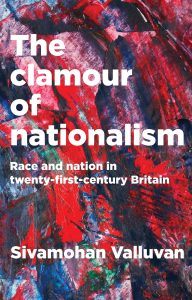In The Clamour of Nationalism: Race and Nation in Twenty-First-Century Britain, Sivamohan Valluvan provides a new examination of the ubiquity of nationalism in Britain today, exploring its capacity to accommodate opposing ideological traditions and extensively critiquing its exclusionary nature. Admiring the intellectual work that underpins the book, Andi Haxhiu highly recommends this well-timed study, which provides an accurate portrayal of contemporary British politics and offers some optimism when it comes to the capacity to oppose the nationalist capture.
The Clamour of Nationalism: Race and Nation in Twenty-First-Century Britain. Sivamohan Valluvan. Manchester University Press. 2020.
Nationalism Never Left
 Find this book (affiliate link):
Find this book (affiliate link): ![]()
The year we have just left behind – 2020 – marked a period of spectacular book and article titles that framed nationalism’s resurgence as a derivative of the inadequate response to the COVID-19 pandemic. Within both media and academic articles, COVID-19 created the perfect storm for many authors to speculate that the pandemic would weaken the project of a borderless world by facilitating the return of the nation state. However, contrary to some of the dramatic tones that have accompanied recent scholarly work on nationalism studies, Sivamohan Valluvan’s The Clamour of Nationalism: Race and Nation in Twenty-First-Century Britain provides an incredibly accurate account of nationalism’s capacity to accommodate opposing ideological traditions and explains its long-lasting ubiquity (13).
By entrenching the nation as modernity’s most abiding project and its most concrete institutional arrangement, Valluvan undertakes an examination of nationalism’s ability to rearticulate a wide variety of political positions by accommodating itself as the common denominator among all quadrants of the political compass. Valluvan hesitates to give credence to arguments that nationalism and the nation state are returning, because, he argues, they never left. On the contrary, it is nationalism’s particular ability to traverse the political spectrum – ‘Left-Liberal-Right’ – that enables it to be the predominant modern formation to generate a conception of peoplehood – a sense of ‘we’. This sense of collective association that facilitates the process of national identification and belonging is rooted in the community’s ability to draw differences with ‘the Other’ as a relational opposite.
For that reason, the book’s title, The Clamour of Nationalism, initiates a necessary reflection on the noise that demands rigorous attention: a noise that is anchored in the inherently exclusionary nature of nationalism. Despite being mainly focused on Britain, Valluvan’s theoretical mapping of the nation understands ‘everyday multiculture’ as a tool that can shape an anti-exclusionary sentiment, challenging nationalism’s Othering character.
Drawing on Gilroy’s After Empire, Valluvan refers to ‘everyday multiculture’ as the ‘highly casual, nigh banal interactive practices that emerge in spaces characterised by ethnic diversities’ that undemonstratively ‘cultivate dispositions less prone to nationalisms and other derivative forms of overtly communitarian claim-making on space, culture and politics’ (203). Therefore, he sporadically shows throughout the book a degree of optimism in the belief that ‘everyday multiculture’ should be understood as a ‘pre-given and natural feature of social life’ and that habituation to such a multicultural environment will render the ‘political appeal to nation to be summarily anachronistic, uninteresting, and, frankly, wrong’ (203). However, as this is only a suggestive take on the probable decline of the nation’s relevance through the left’s anti-nationalist potential, a distinctive part of The Clamour of Nationalism articulates the increasing presence of racism within all spectres of nationalism’s repertoire.

According to Valluvan, the story of nation in Europe, and certainly Britain, cannot be explained independent of the story of race, because the story of nation is one of race (37). Such a premise poses an ambitious attempt to encapsulate the intricate nexus of race and nation and contextualises the idea that national identification derives from non-belonging rather than from belonging. Therefore, by confronting the disturbing presence of the ‘us (that belong) vs them (who do not belong)’ dichotomy, Valluvan delineates nationalism’s exclusionary nature in relationship to black people, Muslims and migrant groups that are constructed as racialised figures. Through a testimony that shows his commitment to the work of his intellectual predecessors like Stuart Hall, Achille Mbembe and Paul Gilroy, Valluvan attempts to deconstruct the inherently divisive discourse that continuously replicates itself: The West versus the Rest. By referring to Gilroy’s groundbreaking work, There Ain’t No Black in the Union Jack, Valluvan explicates brilliantly the ongoing affection that left and right-wing politics have for the nation and demonstrates the inherently nationalist racism instilled in everyday British culture.
With Brexit becoming a reality on 1 January 2021, The Clamour of Nationalism becomes an even more relevant work. It is precisely the ability to smoothly contextualise and interconnect nationalism with muscular liberalism, the post-ethnic nation, left- and right-wing populism and imperialist nostalgia that makes this a highly recommended read and a very accurate portrayal of British politics today.
While substantively agreeing with Valluvan’s scholarly stances, I do, however, have a particular stylistic critique. Characterised by dense theoretical content and sophisticated vocabulary, the book can be hard to read because it requires an advanced command of the English language, despite the self-proclaimed insistence that it targets general audiences. On the other hand, The Clamour of Nationalism also ticks all the boxes for an impressive examination of the nation’s relationship with modernity. For all researchers of nationalism and decolonial studies, it provides a well-thought structure that explains nationalism’s evolution to fill the ideological vacuum among liberal, right- and left-wing politics. Despite the book focusing significantly more on Britain, and as such presenting empirical limitations, it would be wrong to reduce its stances to a particularly British story because Valluvan provides enough generic arguments that apply to nationalism’s presence in a broader global context.
While the critical examination of nationalism’s capacity to adapt within all axes of the political spectrum is theoretically supported by empirical insights throughout the book, it is only in the concluding chapter that the author’s left-leaning political orientation is publicly worn. The concluding remarks posit the idea that the organised left must be the point of departure in shaping an anti-nationalist project. It is here where, contrary to the other respective ideological traditions, Valluvan argues that the left offers the most sustainable political environment to cultivate an ‘everyday multiculture’ sentiment.
However, there are recurring moments throughout the book where Valluvan argues that the left’s connection with the ‘left behind’ – a term used to allude to the white working class that is understood as uniquely marginalised – contributes to the increasingly racialised and exclusionary populist left platform. In parallel with the tendency of the left- and right-wing populist moment in global politics to manifest itself through a sense of victimhood, white working-class nationalism is cultivating a racist rhetoric that seeks to ‘rehabilitate certain anti-migrant and anti-minority attitudes’ (24-25). For that reason, Valluvan argues concerningly that the extensive matrix of populist left-wing motifs has become manifested through a ‘symbolically aggressive nationalist attachment to a notion of authentic white working-class consciousness and history’ (25).
There are, of course, also moments of optimism. The Clamour of Nationalism’s conclusion, for example, proclaims that Corbynism and Britain’s left have provided positive indications that a new forthcoming left-wave is there to resist the contemporary nationalist conjuncture. Consequently, the book reproduces the idea that it is only the left that is capable of generating the necessary surroundings to practise an everyday multiculture sentiment that captures and facilitates an anti-nationalist moment (202).
I must conclude by stressing that this review does not do justice to the admirable intellectual work of Valluvan in The Clamour of Nationalism. This is a well-timed book that provides an extensive account of nationalism’s capacity to fill the ideological vacuum whenever needed to whatever ideological formation. I also appreciated Valluvan’s extensive critique of nationalism’s exclusionary nature and admired the optimistic approach that sees the shaping of an anti-nationalist moment on the left as imperative to oppose the nationalist capture. However, it is here where I feel unsure of the left’s and everyday multiculture’s ability to confront nationalism. It is not only that nationalism has never left, but it shows no indication that it will leave any time soon. Therefore, despite sporadic glimpses of Valluvan’s optimism that the left can battle with nationalist conjunctures, his concerns remain in place and as relevant as ever: nationalism and all its exclusionary forms will remain the everlasting threat to ‘everyday multiculture.’
Note: This review gives the views of the author, and not the position of the LSE Review of Books blog, or of the London School of Economics and Political Science. The LSE RB blog may receive a small commission if you choose to make a purchase through the above Amazon affiliate link. This is entirely independent of the coverage of the book on LSE Review of Books.







